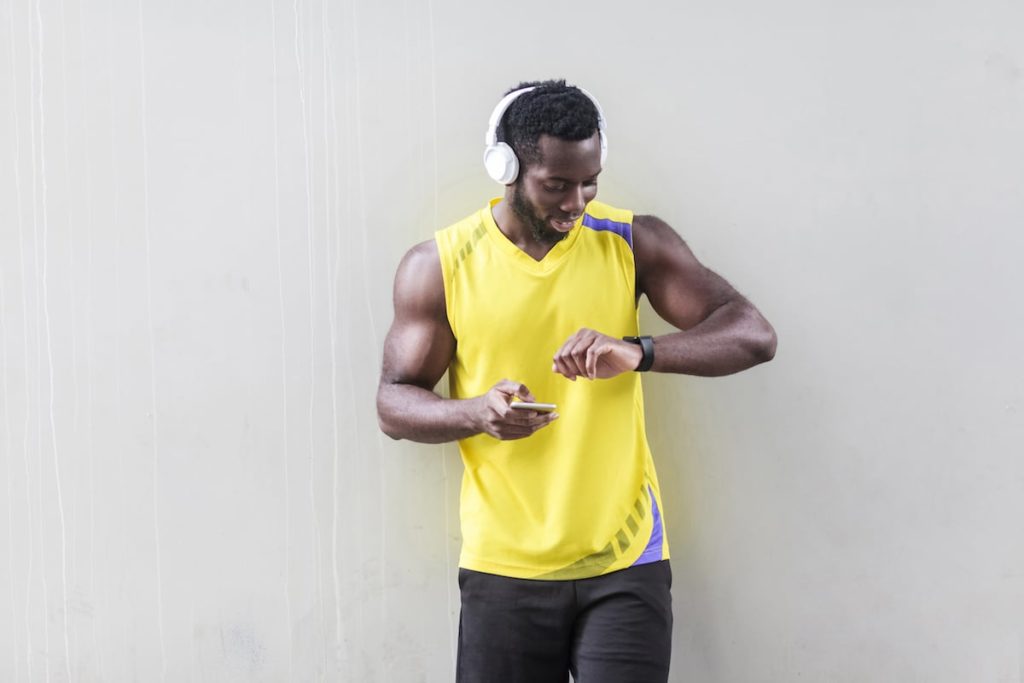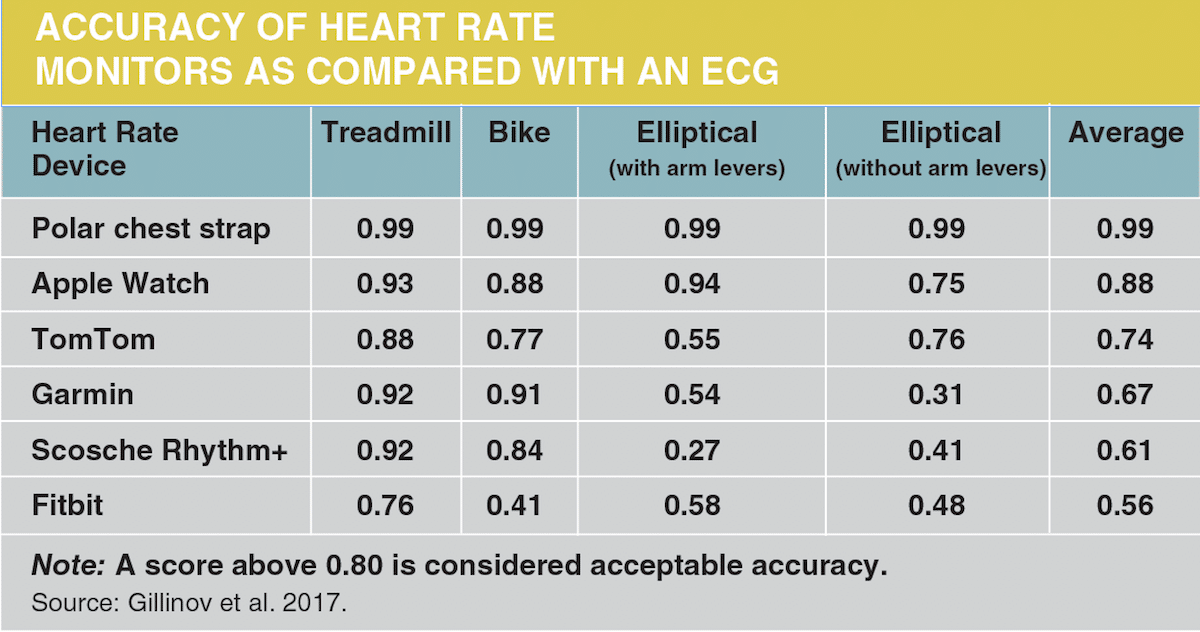Wearable Heart Rate Trackers: Which Works Best?
A study explores the accuracy of five wearable heart rate trackers that use optical sensors.
| Earn 1 CEC - Take Quiz

How accurate are the latest wearable heart rate trackers?
That’s an important question amid the flourishing demand for wearable fitness devices and wrist-worn heart rate monitors. Approximately 1 in 6 consumers in the U.S. uses some type of wearable technology, such as a fitness band or a smartwatch (Piwek et al. 2016). Industry research from 5 years ago predicted sales of 110 million wearable devices by 2018, but shipments of 115.4 million in 2017 have already outpaced that projection (Piwek et al. 2016; IDC 2018).
Historically, the most precise consumer heart rate monitors have used chest straps and electrode attachments. Today’s most popular health and fitness trackers, however, use optical-sensing technology that goes beyond heart rate—potentially measuring changes in an organ or even the entire body. The technology is unlocking potential to monitor a range of health analytics data, including heart rate, body temperature, perspiration, oxygen saturation, physical activity and electrical activity of the skin (Piwek et al. 2016).
Despite all these innovations, however, accuracy remains a paramount concern for exercise enthusiasts, athletes tracking personal progress and physicians monitoring heart rate for specific patient issues. A study last year explored this question, comparing the accuracy of five wearable heart rate trackers that use optical sensors.
Recent Findings on Accuracy of HR Monitors
Study reviewed: Gillinov, S., et al. 2017. Variable accuracy of wearable heart rate monitors during aerobic exercise. Medicine & Science in Sports & Exercise, 49 (8), 1697–703.
Purpose. The study evaluated the precision of five optical-based heart rate–monitoring devices. Four are worn on the wrist: Apple Watch, Fitbit Blaze™, Garmin Forerunner® 235 and TomTom Spark Cardio. The Scosche® Rhythm+ is worn on the forearm.
Participants. Fifty aerobically active men and women (average age: 38; average BMI: 25 kg/m2) volunteered for the study. They were screened to ensure they could safely complete an 18-minute exercise protocol on a stationary bicycle, treadmill and elliptical trainer.
Methods. Each participant wore standard electrocardiograph (ECG) leads, a Polar H7 chest strap monitor and a Scosche Rhythm+ on the forearm. In addition, volunteers were randomly assigned to wear two kinds of wrist-worn heart rate monitors (one on each wrist). Thus, each of these four monitors was tested by 25 of the 50 participants. The study compared the accuracy of all devices against results from the ECG, which provides a visual display of the heart’s electrical activity and measures heart rate with the greatest accuracy.
Exercise protocol. Participants completed a 4.5-minute light, moderate and vigorous exercise sequence (1.5 minutes at each intensity) on each of four pieces of equipment, assigned in a random order: treadmill, stationary bicycle, elliptical trainer with arm levers and elliptical without levers. Subjects rested 2 minutes after completing each modality test. In all, each participant exercised for 18 minutes in a 24-minute test. The researchers explained that they used multiple exercise machines, with three intensities on each machine, because their previous research had determined that new optical devices performed irregularly on various types of exercise equipment at mixed intensities.
Statistical results. The scientists used a specialized correlational approach to compare the accuracy of the devices to that of the ECG. An ECG correlation above 0.80 was considered acceptably accurate. The table on page 14 shows results for each device on each modality.
As expected, the Polar chest strap had the highest ECG correlation, averaging 0.99 on each modality. A comparison of the average correlations of the optical devices found that the Apple Watch performed best (average: 0.88), followed by the TomTom, Garmin, Scosche Rhythm+ and Fitbit (0.74, 0.67, 0.61 and 0.56, respectively).
Discussion of the Results
The first-rate accuracy of the Polar chest strap monitor reflects decades of research and development spent refining this device. The chest strap is used because of its proximity to the heart. Athletes and researchers frequently use chest strap monitors; however, while straps are highly accurate, they are inconvenient for many consumer enthusiasts.
The newer heart rate monitors tested in this study use an optical technology known as PPG, short for photoplethysmography (Gillinov et al. 2017). These devices emit light signals on the skin and perform an optical scan that measures changes in the size of blood vessels just below the skin’s surface. Software interprets these signals to estimate a user’s heart rate. A PPG signal can be read pretty much anywhere on the body, including an earlobe, a wrist or even a finger.
As Gillinov and colleagues discuss, optical-based monitors have limitations. They’re prone to errors caused by physical movements, misalignments between skin and sensor, variations in skin color/tone, and poor tissue perfusion. Optical-based wearables are less accurate than the Polar chest strap, and reliability varies quite a bit from one aerobic activity to the next. These findings suggest that fitness pros should inform clients that such devices are not the most precise tools for assessing, managing and implementing exercise programs.
Note that this study, completed in 2017, reflected the most recent technology available from respected manufacturers. Since optical technology is early in its development, we can assume that manufacturers are making advances with well-conducted research.
Best Practices: Bottom Line
Optical-based wrist-worn heart rate monitors vary in accuracy and perform differently based on the exercise modality. In this study, the Apple Watch came closest to matching the ECG for different modalities at light, moderate and vigorous intensities. However, for now, fitness pros should use the Polar chest strap if they want to test clients with the most accurate heart rate tracker available.
Additionally, until new research suggests otherwise, the best way to estimate maximum heart rate may be with one of these formulas: 206.9 – (0.67 × age) or 208 – (0.7 × age). (For more on this topic, see the sidebar “Q&A: Heart Rate and Wearable Exercise Technology.”)
Why do people buy wearable fitness trackers?
Ideally, wearables can provide all-inclusive platforms for heart rate measurement during exercise. Clearly, consumers are embracing that ideal, although it remains somewhat out of reach because the technology is so new. Even with the current limitations, these devices can contribute to positive habit formation, stress management, and improvements in sleep, productivity and physical fitness (Piwek et al. 2016).
What formula is best for estimating maximum heart rate?
Although the 220-minus-age estimated maximum heart rate calculation is easy to compute, it was never intended for the general population and is prone to considerable error (approximately ┬▒12 beats per minute). Foster & Porcari (2014), in the ACE Personal Trainer Manual (5th ed.), recommend using two other formulas to estimate maximum heart rate; they have an error potential of about 7 beats per minute.
- Gellish et al. formula: 206.9 – (0.67 ├ù age)
- Tanaka, Monahan & Seals formula: 208 – (0.7 ├ù age)
How useful are the wearable devices in changing behavior?
While few randomized controlled studies have focused on the impact of wearable technology on health behavior change (Piwek et al. 2016), these monitors include goal-setting, self-monitoring and feedback content that closely matches recommendations for positive behavior change. Therefore, the future of this technology has broad applications for use in fitness, medicine, public health and rehabilitation.
References
Foster, C., & Porcari, J.P. 2014. Cardiorespiratory training: Programming and progressions. In C.X. Bryant & S. Merrill (Eds.), ACE Personal Trainer Manual (5th ed.). San Diego: American Council on Exercise.
IDC (International Data Corp.) 2018. Global wearables market grows 7.7% in 4Q17 and 10.3% in 2017 as Apple seizes the leader position, says IDC. Accessed June 8, 2018: idc.com/getdoc.jsp?containerId=prUS43598218.
Piwek, L., et al. 2016. The rise of consumer health wearables: Promises and barriers. PLOS Medicine, 13 (2), e1001953.
Len Kravitz, PhD
Len Kravitz, PhD is a professor and program coordinator of exercise science at the University of New Mexico where he recently received the Presidential Award of Distinction and the Outstanding Teacher of the Year award. In addition to being a 2016 inductee into the National Fitness Hall of Fame, Dr. Kravitz was awarded the Fitness Educator of the Year by the American Council on Exercise. Just recently, ACSM honored him with writing the 'Paper of the Year' for the ACSM Health and Fitness Journal.







